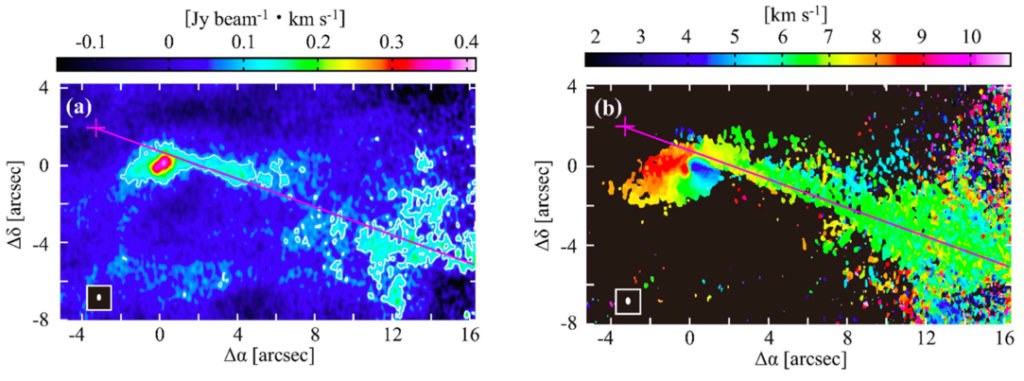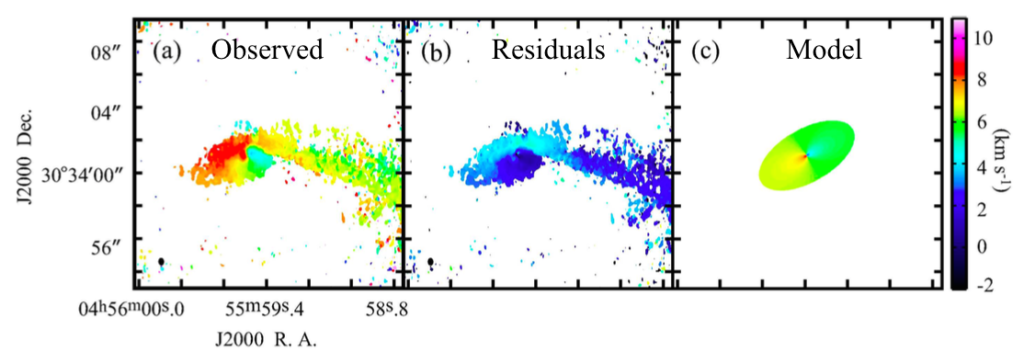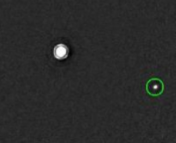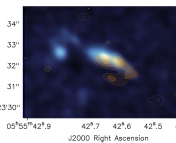Title: A Tail Structure Associated with a Protoplanetary Disk around SU Aurigae
Authors: Eiji Akiyama, Eduard I. Vorobyov, Hauyu Baobabu Liu, Ruobing Dong, Jerome de Leon, Sheng-Yuan Liu, Motohide Tamura
First Author’s Institution: Institute for the Advancement of Higher Education, Hokkaido University, Sapporo, Japan
Status: Published in The Astrophysical Journal [open access on arXiv]
The Diversity of Protoplanetary Disks
The formation of our solar system traces its history back to a swirling cloud of primordial gas and dust. New observations of protoplanetary disks – the cradles of planet formation – toward other stars have revealed unexpected chemical complexity, dust substructure in the form of rings and gaps, and even spirals arms. Although once thought to be nearly featureless and relatively homogenous, the varied nature of disks continue to surprise astronomers with unanticipated structures, orbital oddities, and collisionally-restructured systems all having been recently discovered. One such surprising disk around SU Aurigae (SU Aur) is the subject of today’s astrobite.
The Gaseous Tail Associated with Protoplanetary Disk SU Aurigae
Today’s authors used ALMA to observe CO gas in the protoplanetary disk around SU Aur, which is located 470 lightyears away from Earth in the Taurus-Auriga star forming region. Previous scattered light observations of SU Aur – a 7 Myr old, solar-type star – revealed the presence of a long tail-like structure in small dust grains. This dust tail was found to extend more than 350 AU in length from the disk body out to the west. The discovery of this giant dust tail, nearly 7x the size of our solar system, motivated the search for a counterpart gaseous tail. To do so, today’s authors used a rotational transition of CO, a well-known gas tracer in protoplanetary disks.
The results of their search are shown in Figure 1. A gaseous disk component near SU Aur and a tail-like structure more than 1000 AU long extending from the northern part of the disk to the southwest direction are clearly visible. Based on these geometric and kinematic perspectives, both the disk and tail-like structure are physically connected to each other. Importantly, the close association of this tail means that it is likely involved in mass transfer from or into the disk.

Figure 1: (a) Total radio emission from CO around the SU Aur disk taken with ALMA. The image is centered on the central young star in SU Aur. Brighter colors and additional contours represent increasing strength of the signal from CO gas. The x- and y-axes are in equatorial coordinates in terms of arcseconds. The white circle in the lower left indicates the resolution of the radio observation. (b) Same as in panel (a) but now gas velocity is shown.
Mapping Gas Kinematics around SU Aurigae
To better understand the gas motions associated with this extended tail, the authors generate a simple Keplerian disk model in the same orientation as the observed disk component. They then computed the residuals after subtracting this model from the observed velocity map, as shown in Figure 2. In this model, the gas in the SU Aur disk is assumed to be moving at the Keplerian velocity in a circular orbit around the central star. Through this modeling, near zero velocity residuals are obtained in the southern part of the disk, indicating that this portion of the disk is relatively unperturbed due to the tail-like structure. However, the velocity component in the northern part of the disk is not well-fitted via Keplerian rotation with residuals up to 4 km/s, which implies that gas in the northern part of the disk has been disturbed by the gaseous tail.

Figure 2: (a) Measured velocity of CO gas around the SU Aur disk. Both disk component and extended tail are clearly seen. (b) The residuals left over after subtracting the Keplerian rotation disk model. These velocities correspond to deviations from Keplerian rotation due to gas motions from the extended tail. (c) A simple Keplerian rotation model in the same orientation as the observed SU Aur disk.
The Origins of the Tail-like Structure:
The authors present three possible mechanisms to explain the observed tail in SU Aur and we summarize these briefly:
1. A close encounter with a (sub)stellar object passing through the outer regions of the disk. The colliding object drags some disk material with it and elongates one side of the disk in the direction of the collider’s trajectory when it passes near to the outer disk edge. The tail then becomes curved with time, likely as a response to disk rotation.
2. Disk interactions with an external molecular cloud, which channels its material to the disk via a filamentary-like stream. Since SU Aur is not located at the center of its parent molecular cloud’s gravitational potential well, the cloud material first falls towards its global potential well and then is attracted towards SU Aur in the form of a narrow stream.
3. The ejection of a planetary or brown dwarf mass object from the disk due to gravitational instability. The disk mass of SU Aur is sufficient for the ejection scenario, which requires a massive enough disk to induce gravitational instability and disk fragmentation.
Of these three possibilities, the authors believe that a collision with a (sub)stellar intruder or a gaseous blob is probably the most plausible explanation based on physical properties of SU Aur. The authors also note that to truly confirm the origin of this tail-like structure, observations of additional molecules like SO, which trace shock-heated gas, are needed.
The discovery of a tail-like features in a protoplanetary disk such as SU Aur provides direct evidence that some disk systems are shaped by internal or external gravitational influences and may lose a large amount of disk mass during their evolution. Such events will likely have dramatic impacts on the development of planetary systems and may help explain the wide variety of planetary configurations reported in exoplanet observations.




